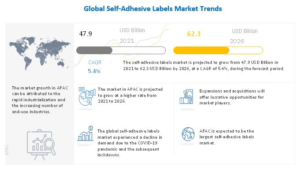As per the Report by MarketsandMarkets™ The global self-adhesive labels market size is projected to grow from USD 47.9 billion in 2021 to USD 62.3 billion by 2026 at a CAGR of 5.4% from 2021 to 2026. The global self-adhesive labels market size is projected to grow from USD 47.9 billion in 2021 to USD 62.3 billion by 2026, at a CAGR of 5.4% from 2021 to 2026. The self-adhesive labelss market is expected to witness high growth because of increase rapid urbanization, demand for pharmaceutical supplies, increasing consumer awareness, and growth of the e-commerce industry. With the increasing demand for convenience and quality food products, people are opting for packaged food products, where the product information and other details such as nutritional values of the product and manufactured & expiry dates need to be printed; this is an opportunity for self-adhesive label manufacturers.
In terms of value, the release liner segment is estimated to lead the self-adhesive labels market in 2020.
Release liner, by type, accounted for the largest market share in the self-adhesive labels market. Release liner labels are normal self-adhesive labels with an attached liner; they can be made available in different shapes and sizes, as they have the release liner in place to hold labels when they are die-cut. Release liner labels can be easily cut into any shape, whereas linerless labels are restricted to squares and rectangles. However, the market for linerless labels is projected to grow at a steady rate, as is the market for release liner labels. This is because linerles labels are preferred from an environmental point of view as their production generates less wastage and requires less paper consumption.

In terms of value, permanent segment is estimated to be the fastest-growing segment in the self-adhesive labels market.
The permanent segment accounted is estimated to be the fastest-growing segment in the self-adhesive labels market. Permanent labels are the most common and cost-effective labels and can only be removed with the help of solvents as their composition is made to be non-removable. The application of permanent adhesives on self-adhesive labels usually depends on the substrate and surface material as well as the environmental conditions such as UV (ultraviolate) exposure, moisture, temperature range, and contact with chemicals. Removing a permanent label destroys it. Hence, these labels are suitable for non-polar surfaces, films, and corrugated board; these are not recommended for labeling highly curved surfaces.
The APAC region is projected to be the fastest-growing region in the self-adhesive labels market during the forecast period.
The APAC region is projected to be the fastest-growing region in the self-adhesive labels market in terms of both value and volume from 2021 to 2026. This region is witnessing the highest growth rate due to the rapid economic expansion. The usage of self-adhesive labels in the region has increased due to cost effectiveness, easy availability of raw materials, and demand for product labeling from highly populated countries such as India and China. The increasing scope of applications of self-adhesive labels in the food & beverage, healthcare, and personal care industries in the region is expected to drive the self-adhesive labels market in APAC. The growing population in these countries presents a huge customer base for FMCG products and food & beverages. Industrialization, growing middle-class population, rising disposable income, changing lifestyles, and rising consumption of packed products are expected to drive the demand for self-adhesive labels during the forecast period.
CCL Industries Inc. (Canada), Avery Dennison Corporation (US), Multi-Color Corporation (US), Coveris Holdings S.A. (Austria), Huhtamaki OYJ (US), and Fuji Seal International (Japan), amongst others, are the key players operating in the self-adhesive labels market.












